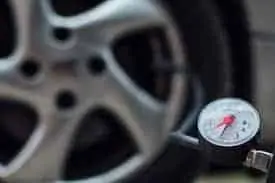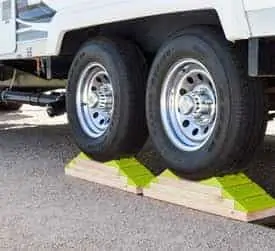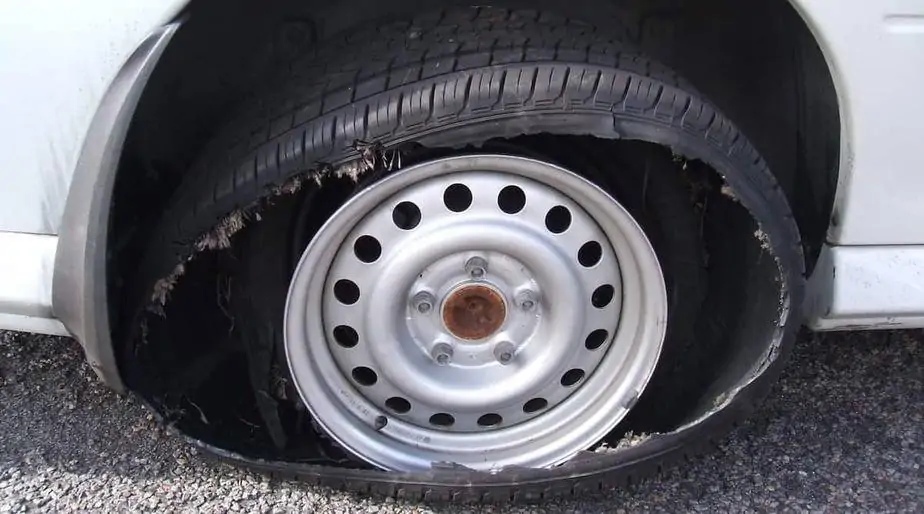RVs are more likely to suffer from tire blowouts than standard vehicles for several reasons. These include:
- RVs tend to carry a load weight far greater than commuter vehicles. This can put additional strain on your tires
- As RVs are usually driven on road trips, they are often driven for long periods of time in one go. This can put tires at the risk of blowout due to overheating.
- RVs are often driven over a number of different terrains in one trip. This can make selecting the right tires for your trip challenging, and using inappropriate tires can make them more likely to blowout
- RVs are often driven daily for a period of time and then can spend the next few months (or longer)not being driven at all. This means that tires are at greater risk of dry rotting which can also increase their chances of blowing out.
We will now go through the key precautions that you should take to minimize the chances of tire blowouts happening on your RV.
Contents
Be Sure That Your Tires Are At Their Optimal Inflation

Underinflated are more likely to blow out as these tires’ additional elasticity forces downward pressure from the vehicle away from the tread of the tire (the part of the tire where it meets the road) to the tire’s sidewall.
Tires’ sidewalls are more brittle than their treads. They therefore cannot take as much downwards pressure. The pressure put on the tire’s sidewall when tires are being driven at below maximum inflation can therefore make tires far more likely to blow out.
Although most modern tires are fitted with a tire pressure monitoring system, these often only flag up when a tire is 10% below its maximum inflation. As tire blowouts are made more likely even when a tire is 5% below its maximum inflation, we’d still recommend that you manually check your tire pressure every 2,000 miles driven.
It’s easy to manually check your tire pressure. All you need to do this is a tire pressure gauge. These cost around $10.
If you are traveling in more rural areas, we’d also recommend traveling with a tire pump. These cost around $30-50 and are small enough to take up very little RV space.
You should pump up your tire if they fall more than 5% lower than their recommended inflation in your driver’s manual. This can often be as little as 2-3 PSI lower than their recommended inflation.
Do Not Overload Your RV

If your RV carries too much weight then this can put undue pressure on your tires. Again too much downward pressure can see the sidewalls of your tires taking some of the load and as these parts of the tires are relatively brittle, they can be prone to blowing out under such stress.
There are four maximum weights that RV owners should know about depending on the type of vehicle that they have. These are:
Gross Vehicle Weight Rating (GVWR): This is the maximum weight that your vehicle can safely handle including all its contents. Please remember that this includes the weight of the people in the vehicle.
Gross Trailer Weight Rating (GTWR): If you are hauling your RV, then GTWR refers to the amount of weight that your trailer can carry including all its contents. It is essentially GVWR but for trailers
Gross Combined Weight Rating (GCWR): This is the maximum weight that your vehicle and trailer can be together along with all its contents. Please beware that it will sometimes be lower than the sum of your GVWR and your GTWR.
Tire Load Index: This refers to the maximum weight that your tires can safely carry. You can find your tire’s load index as the final two digits on the outer ring of letters and numbers on your tire’s sidewall. This number refers to a specific maximum weight which you can find out in this chart.
If you are unsure whether your RV exceeds any of these weight limits it may be worth taking it to a truck weighing station before you set off on your trip.
Use The Right Tires For The Terrain You Are Going To Travel On
Traveling on the wrong tires for your terrain can make tire blowouts more likely for several reasons. If you are traveling off-road with tires that were designed to be driven on tarmacked roads, your chances of suffering a slow puncture are much higher and this loss of inflation can in turn lead to a tire blowing out.
Similarly, if you are traveling for long distances on highways and you are traveling on off-road tires then the tires can blow out due to overheating.
As a general rule, you should use the following tires for the following terrains:
Highway driving: If you plan to travel near exclusively on highways, and you will travel on highways for long periods of time, you should use either standard or low rolling resistance tires. Low rolling resistance tires are designed to reduce the amount of friction created between the tire and the road when driving and can therefore prevent blowouts caused by overheated tires.
Off-road driving: If you are driving on dirt, grass, or gravel you should use tires that have at least a 12 ply rating. These tires are thicker than standard tires and can withstand punctures from debris typically found on these terrains. Tires over 10 ply are often described as off-road tires for this reason.
Combination driving: If you are driving on a combination of terrains in one trip it’s a good idea to use all-season tires. This will offer you a nice balance between durability on rougher terrains and a decent fuel economy on smoother terrains.
Do Not Let Your Tires Overheat
As your tires warm up from friction against the road the pressure in them rises. If the pressure in a tire gets too high then it is at risk of literally bursting.
On hotter days (over 90 degrees Fahrenheit) you should therefore take additional precautions to stop your RV’s tires from overheating. These precautions include:
Keeping your tires fully inflated: When tires fall below their optimal inflated, a greater amount of the tire tread comes into contact with the road. This increases the friction between the tire and the road and therefore raises the heat within the tire. If you are regularly traveling in temperatures above 90 degrees Fahrenheit then you should check your tire pressure every 1000 miles rather than every 2000 miles.
Taking regular breaks from driving: Try to take at least a 30-minute break every 3 hours that you drive on the highway. This should give your tires enough time to cool back down to safe levels if they are getting close to overheating.
Use low rolling resistance tires: We’d recommend using low rolling resistance tires if you are driving for long periods of time at high speeds in hot conditions as these tires are specifically designed to minimize the amount of friction created between the tire and the road. As a result, low rolling resistance tires will get less hot than regular tires if all else is equal.
Park in the shade or on the grass where possible: Asphalt absorbs heat very effectively. Therefore keeping your vehicle on a paved road in direct sunlight can cause your tires to get very hot before you even start driving. On hot days try to keep your vehicle parked out of direct sunlight and off asphalt if possible.
Please note that although overheating can lead to tire blowouts due to the pressure in tires becoming too high, underinflation is still a far more common cause of blowouts than overinflation. Therefore you should always look to keep your tires at their recommended level of inflation.
Store Your Vehicle In a Way That Reduces The Rate at Which Dry Rotting Occurs In Tires

Stationary tires are susceptible to dry rot as the resins that keep tires moist need downwards pressure applied to them to be activated. A lack of this downwards pressure (due to inactivity) can therefore see tires dry out, become brittle, and therefore more prone to blowing out.
As well as a lack of use, dry rotting is also exacerbated by exposure to heat, excessive moisture, and dryness, as well as UV rays.
Storing your vehicle in a cool dry area and away from direct sunlight should help slow the rate at which dry rotting occurs. You should take your RV for a drive every now and then if you have the ability to do so. Just driving on your tires for a few hours each month should help work those essential resins back into the rubber.
If You Are Purchasing a Second-hand RV Make Sure The Tires Are In Good Condition
If you are purchasing an RV second-hand then it’s worth inspecting the tires as tires with certain types of visible wear or damage are significantly more likely to suffer a blowout. The types of wear or damage that you should look out for when inspecting the tires of a vehicle that you might buy include:
The age of a tire: You can find the age of a tire by looking at the final four digits on the innermost ring of letters and numbers on a tire’s sidewall. The final four digits refer to the week and the year that a tire was manufactured. Therefore if the final four digits read 0220 then the tire was manufactured in the second week of 2020. You should not drive on tires that are more than 6 years old.
Cracks or dents on the tire’s sidewall: You should not drive on tires that have any visible damage to their sidewall as these are the most fragile parts of a tire. Look closely at a tire’s sidewall and run your hands over it to check for any cracks, dents, or uneven areas.
Uneven wear on a tire’s tread: Although uneven wear itself does not make a tire more prone to blowing out, it can be a sign that tires have regularly been driven on at the incorrect inflation. This can make them more prone to blowing out. Run your hand over the tire’s treads. Their tread pattern should feel homogenous. If they are not then ask the current owner how diligent they have been about keeping their tires inflated.
Tread depth: You should not drive on tires that have less than 4/32s of tread depth. It may be worth taking a tread depth gauge when you go to see an RV that you may buy.
If an RV that you are interested in buying has any of these issues with its tires then you should try and negotiate the price of replacing tires off of the cost of the vehicle.
Conclusion
Although you can never prevent tire blowouts entirely, following good tire care can drastically reduce your chances of suffering a tire blowout on your RV.
Keeping your tires at their correct inflation is by far the most important step in reducing the likelihood of a blowout. Keeping a tire pressure gauge and pump in your RV should be a must for any road trip.
